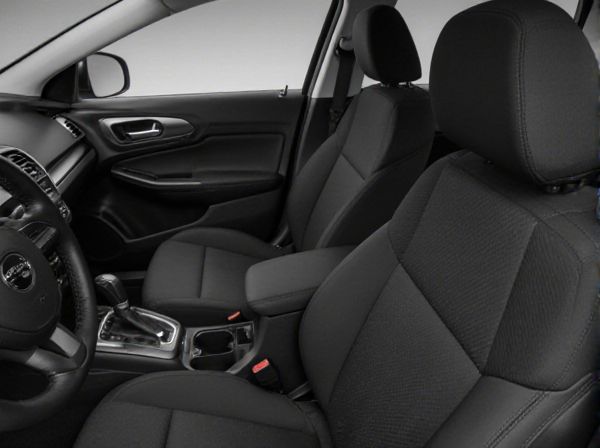
Photo illustration: Manual Adjustment Seat vs Power Adjustment Seat
Manual adjustment seats offer direct control through levers and knobs, allowing you to customize your seating position without relying on electronics, making them typically more affordable and less prone to mechanical failure. Power adjustment seats provide enhanced convenience with electric motors enabling precise positioning at the push of a button, often including features like memory settings, lumbar support, and multiple adjustment directions. Choosing between manual and power adjustment seats depends on your preference for ease of use, budget considerations, and desired comfort features in your vehicle.
Table of Comparison
| Feature | Manual Adjustment Seat | Power Adjustment Seat |
|---|---|---|
| Adjustment Mechanism | Lever and mechanical controls | Electronic controls with motorized adjustments |
| Precision | Basic, limited increments | Highly precise, multiple settings |
| Convenience | Requires physical effort | Effortless with push-button controls |
| Adjustment Options | Typically 2-3 directions (forward/backward, recline) | Multiple directions including lumbar support |
| Memory Function | No memory settings | Stores multiple driver profiles |
| Cost | Lower cost | Higher cost |
| Reliability | Less prone to electrical failure | Potential issues with motors/electrical parts |
| Energy Use | No power consumption | Uses vehicle electrical power |
Introduction to Car Seat Adjustment Types
Manual adjustment car seats rely on mechanical levers and knobs for positioning, offering cost-effective and straightforward control over seat height, recline, and fore-aft movement. Power adjustment seats utilize electric motors controlled by switches or buttons, enabling precise and effortless customization of seating positions, often including memory settings for multiple drivers. The choice between manual and power adjustment seats impacts comfort, convenience, and vehicle price.
What Is a Manual Adjustment Seat?
A manual adjustment seat allows drivers to change seating positions using levers and knobs without electrical power, offering straightforward control over seat height, distance, and backrest angle. It is typically lighter and less expensive than power adjustment seats, making it common in entry-level vehicles. Manual seats provide a reliable, low-maintenance option, ideal for drivers who prefer simplicity and durability.
What Is a Power Adjustment Seat?
A power adjustment seat uses electric motors controlled by switches to customize seating positions with precision, offering features like lumbar support, height, tilt, and recline adjustments. These seats enable quick and effortless modifications compared to manual adjustment seats, which rely on physical levers and knobs requiring more effort. Advanced power seats often include memory settings, allowing multiple drivers to save preferred positions for enhanced comfort and convenience.
Key Differences Between Manual and Power Seats
Manual adjustment seats rely on mechanical levers and knobs to change seating position, offering basic control and requiring physical effort. Power adjustment seats use electric motors activated by buttons, allowing precise positioning with minimal effort and often include memory settings for multiple drivers. Key differences include convenience, range of motion, and cost, as manual seats are typically less expensive but less adjustable compared to power seats with advanced customization features.
Comfort and Customization: Manual vs Power
Manual adjustment seats provide basic comfort with straightforward controls, allowing users to easily modify seat position through levers and knobs, suitable for quick, simple adjustments. Power adjustment seats offer enhanced comfort through multiple customizable settings, including lumbar support, height, tilt, and memory functions, enabling precise ergonomic positioning tailored to individual preferences. The advanced customization features of power seats support improved posture and reduced fatigue during long drives compared to manual seats.
Cost Comparison: Manual vs Power Adjustment Seats
Manual adjustment seats typically cost significantly less than power adjustment seats due to simpler mechanical components and reduced manufacturing complexity. Power adjustment seats involve electric motors and control systems that increase production and repair expenses, often adding several hundred dollars to the vehicle's price. Choosing manual seats offers budget-friendly pricing with basic functionality, while power seats incur higher upfront and maintenance costs but provide enhanced convenience and customization.
Maintenance and Durability Considerations
Manual adjustment seats generally require less maintenance due to their simpler mechanical components, reducing the risk of electronic failures and costly repairs. Power adjustment seats incorporate motors and wiring that may require periodic inspections and potential replacements, impacting long-term durability if exposed to moisture or heavy use. Choosing between the two depends on balancing the ease of adjustment provided by power seats against the lower maintenance demands and higher durability of manual seats.
Safety Features and Concerns
Manual adjustment seats often provide a more straightforward mechanism with fewer electronic components, reducing the risk of malfunction during critical moments. Power adjustment seats incorporate advanced safety features such as memory settings that automatically reposition seats to optimal driving postures and sensors that prevent injury by stopping movement upon detecting obstructions. However, power seats may pose concerns related to electrical failures or sensor errors, necessitating regular maintenance to ensure safety functions operate reliably.
Ideal Users for Manual and Power Seats
Manual adjustment seats are ideal for budget-conscious drivers who prefer straightforward controls and minimal maintenance, commonly found in economy cars and entry-level vehicles. Power adjustment seats suit users seeking personalized comfort with features like multi-directional adjustments, memory settings, and lumbar support, often favored by luxury car owners and those with mobility concerns. Both seat types address different ergonomic needs, with manual seats emphasizing durability and simplicity, while power seats prioritize convenience and advanced customization.
Choosing the Right Seat Adjustment for Your Needs
Manual adjustment seats offer direct control and simplicity, making them ideal for budget-conscious drivers who prefer straightforward, reliable settings without electronic reliance. Power adjustment seats provide enhanced precision and convenience with multiple customizable positions, suitable for users seeking comfort and ease, especially during frequent vehicle use or long trips. Evaluating daily driving habits, budget, and comfort preferences helps determine the optimal seat adjustment type for individual needs.
 caratoz.com
caratoz.com